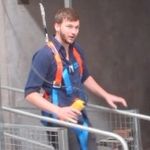It is not unusual to find that tiles that have been installed achieve a lower slip resistance than the same tiles that have been tested straight out of the box. There are several reasons why the results of a wet pendulum slip test done onsite to AS4663 could have a different result to one done in the laboratory to AS4586.
Some possible reasons for the lower slip resistance in installed tiles are; the process of installing the tiles due to wear from grouting, handling of the tiles or even just the first few people to walk over the tiles, chemicals or residues that are still present from production, or cleaning after installation, or even environmental factors such as sunlight or rain for external areas.
The Accelerated Wear Test can give some insight into how a tile will perform in regards to slip resistance over the life of the tile. The test is a series of wet pendulum slip resistance tests performed before, during and after the tile is worn down by running an abrasive pad over the surface. Plotting the result of the pendulum tests against how many cycles the pad had been run over the surface can then be used to show how the slip resistance of the tile may be affected by its use and cleaning.
Each batch of tiles is different and so therefore so will each accelerated wear result may be different, but there is a common trend; an initial quick drop in slip resistance, which then plateaus out. Which shows that with most tiles, the main loss of slip resistance occurs quickly and at the start of their life. The accelerated wear test is a good tool to use when selecting tiles, as planning on having an adequate slip resistance down the track can save time and money in anti-slip treatments and replacing of the surface.
An exact time frame cannot be associated with the accelerated wear test because the amount of wear is dependent on the frequency of use and the type of traffic over the floor. For example, a tile laid on a residential balcony will wear slower than if that same tile was laid in a busy shopping centre due to the frequency of use.
For more information on control measures to reduce the risk of slip and falls, including Accelerated Wear testing, please contact the Slip Check team at Safe Environments in Sydney or Melbourne.
Author: Ryan Voorderhake

Email: info@SafeEnvironments.com.au
Ryan Voorderhake is a tertiary qualified slip resistance testing consultant with Safe Environments having a completed a Bachelor of Forensic Science (Honours) in Applied Chemistry at the University of Technology, Sydney. Ryan is proficient having undergone successful completion of Safe Environments NATA endorsed training program in wet pendulum testing, dry floor friction testing, oil wet ramp testing and pendulum calibrations to the Australian Standards AS 4586 & AS 4663. With a size 13 boot, Ryan is the giant of floor slip testing when undertaking the oil wet ramp test.
Ryan is proficient in conducting luminance reflectance testing to determine compliance with luminance contrast testing. Luminance contrast testing is a useful aid to assist visually impaired persons in wayfinding.
As well as a qualified floor slip tester, Ryan utilises his forensics degree in conducting asbestos analysis and materials testing duties for ceramic and stone tiling systems.


